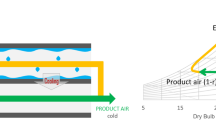Abstract
The high temperature heat pump and desiccant wheel (HTHP&DW) system can make full use of heat released from the condenser of heat pump for DW regeneration without additional heat. In this study, DW operation in the HTHP&DW system was investigated experimentally, and the optimization analysis of HTHP&DW system was carried out. The performance of DW had influence on the dehumidification (evaluated by dehumidification and regeneration effectiveness) and cooling load (evaluated by thermal and adiabatic effectiveness). The results show that the enthalpy increase occurred in all the experiments. Compared to the isosteric heat, heat accumulation in the desiccant and matrix material and heat leakage from regeneration side to process side have greater influence on the adiabatic effectiveness. Higher regeneration temperature leads to lower adiabatic effectiveness that increases more cooling load of the system. When the regeneration temperature is 63°C, the maximal dehumidification effectiveness is 35.4% and the satisfied adiabatic effectiveness is 88%, which contributes to the optimal balance between dehumidification and cooling.
Similar content being viewed by others
References
Hao H, Zhang Y F, Zhou G B. Feasibility study of moderate or high temperature heat pump coupling to desiccant wheel hybrid system [J]. Journal of Shenyang Jianzhu University: Natural Science, 2008, 24(4): 675–678 (in Chinese).
Zhang Y F, Hu X W, Miao Z S et al. Cycle performance of heat pump in desiccant cooling system [J]. Journal of Chemical Industry and Engineering, 2009, 60(9): 2177–2182 (in Chinese).
Sheng Y, Zhang Y F, Deng N et al. Experimental analysis on performance of high temperature heat pump and desiccant wheel system [J]. Energy and Buildings, 2013, 66: 505–513.
Zhang L Z, Niu J L. Performance comparisons of desiccant wheels for air dehumidification and enthalpy recovery [J]. Applied Thermal Engineering, 2002, 22(12): 1347–1367.
Esfandiari Nia F, Van Paassen D, Saidi M H. Modeling and simulation of desiccant wheel for air conditioning [J]. Energy and Buildings, 2006, 38(10): 1230–1239.
Jia C X, Dai Y J, Wu JY. Performance optimization of silica gel-lithium chloride composite desiccant dehumidification wheel[J]. Gas and Heat, 2008, 28(10): A30–A32 (in Chinese).
Dai Y J, Wang R Z, Zhang H F. Parameter analysis to improve rotary desiccant dehumidification using a mathematical model[J]. International Journal of Thermal Science, 2001, 40(4): 400–408.
Zhang X J, Liu H X, Wang R Z et al. Numerical simulation of heat transfer in regenerator of solid adsorption refrigeration system [J]. Renewable Energy, 2002, 26(4): 599–610.
Kodama A, Hirayama T, Goto M et al. The use of psychrometric charts for the optimization of a thermal swingdesiccant wheel[J]. Applied Thermal Engineering, 2001, 21(16): 1657–1674.
Zhang X J, Dai Y J, Wang R Z. Psychrometric analysis and optimization of a desiccant rotary wheel [J]. Journal of Engineering Thermophysics, 2005, 26(5): 733–735 (in Chinese).
Mandegari M A, Pahlavanzadeh H. Introduction of a new definition for effectiveness of desiccant wheels[J]. Energy, 2009, 34(6): 797–803.
Angrisani G, Capozzoli A, Minichiello F et al. Desiccant wheel regenerated by thermal energy from a mirocogenerator: Experimental assessment of the performances[J]. Applied Energy, 2011, 88(4): 1354–1365.
Angrisani G, Minichiello F, Roselli C et al. Experimental analysis on the dehumidification and thermal performance of a desiccant wheel[J]. Applied Energy, 2012, 92: 563–572.
Wang Y, Zhang Y F. Analysis of the dilatancy technology of district heating system with high-temperature heat pump[J]. Energy and Buildings, 2012, 47: 230–236.
Kline S J, McClintock F A. Describing uncertainties in single-sample experiments[J]. Mechanism Engineering, 1953, 75: 3–8.
Enteria N, Yoshino H, Satake A et al. Experimental heat and mass transfer of the separated and coupled rotating desiccant wheel and heat wheel[J]. Experimental Thermal and Fluid Science, 2010, 34(5): 603–615.
Author information
Authors and Affiliations
Corresponding author
Additional information
Supported by the Danish International DSF Project (No. 09-71598) and Chinese International Collaboration Project (No. 2010DFA62410).
Sheng Ying, born in 1984, female, lecturer.
Rights and permissions
About this article
Cite this article
Sheng, Y., Zhang, Y., Fang, L. et al. Optimization analysis of high temperature heat pump coupling to desiccant wheel air conditioning system. Trans. Tianjin Univ. 20, 182–188 (2014). https://doi.org/10.1007/s12209-014-2191-0
Accepted:
Published:
Issue Date:
DOI: https://doi.org/10.1007/s12209-014-2191-0




